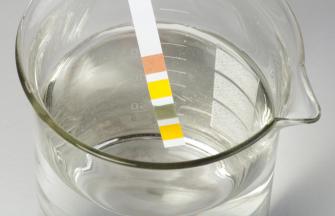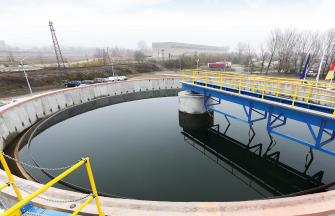
Lime products maintain proper pH control for water and perform well when utilized as coagulation/flocculation chemicals, and they provide cations to neutralize negative surface charges. Water treatment with lime softening has been proven to remove many different gaseous acidic contaminants commonly found in industrial waste, including tannins, arsenic, barium, lead, nickel, cadmium, chromium, and other metals.
While other substitutes for lime exist such as soda ash, magnesium hydroxide, some acidic metals, this article will focus primarily on pH control and adjustment, and compare the advantages, disadvantages, and chemical properties of lime and caustic soda (sodium hydroxide).
Lime VS Caustic Soda: Which Product is Better for What?
Slaked lime, which is Ca(OH)2 in excess water, is also known as lime slurry. Both lime slurry and caustic soda/Na(OH), are common alkali chemicals used for pH control and adjustment in the wastewater treatment field.
Both chemicals operate the same way to neutralize gaseous acidic contaminants by providing a source of hydroxide. However, there are important differences between the two, and each has advantages and disadvantages.
Lime
Lime products generally come in four forms. Limestone (CaCO3) is the most unrefined lime product from which all other lime products are ultimately derived. Limestone is of course a solid stone that can come in a wide variety of size ranges. Limestone can be used for acid neutralization in some special industrial processes but will be considered outside of the scope of this document. Quicklime (CaO) is limestone that has been calcined in a kiln. This product is shipped as a solid but is typically chemically converted into lime slurry by the consumer at their facility. Hydrated Lime (Ca(OH)2) is a product derived from quicklime that has already been hydrated with a controlled amount of water to remove its exothermic heat of reaction. Hydrated lime is a dry product with a powdery size and consistency. Finally, Calsafe, more generally called lime slurry, is the only liquid form of calcium products.
Lime products are not as hazardous as caustic soda (sodium hydroxide) and are the more economically favorable alkaline additives for industrial processes such as acid neutralization, pH adjustment and metals removal. Quicklime also has a stronger neutralizing capacity per dry ton; so less material needs to be used. An investment of equipment is needed, and a sludge volume is produced, but it is often low-volume and simple to handle.
Caustic Soda
Caustic soda (sodium hydroxide) is available as a liquid in both 20% and 50% solutions and does an excellent job with pH control in the wastewater treatment field. It is easy to handle and it disperses well. Oftentimes, caustic soda is easier to store and handle. Also, in regards to pumping equipment maintenance, with caustic soda, less maintenance is required. The sludge volume produced by caustic soda is less than the sludge volume produced by lime. A downside to caustic soda is that it is extremely hazardous in terms of exposure to the skin and eyes and can cause chemical burns. While severe burns are not common, there is a possibility. While caustic soda does not require the initial equipment capital investment that lime does, it still can be significantly more expensive overall because of its high cost per ton.
Let us look in more detail at a comparison of their physical characteristics, solubility, pH range, reaction products formed, and cost in more detail.
Physical Characteristics of Caustic Soda and Lime
Lime
Lime products include quicklime, CaO, a solid material available in a variety of sizes from pebble down to fines, hydrated lime, Ca(OH)2 or calcium hydroxide, as a powder or as a slurry. Unlike caustic soda, lime slurry begins to freeze at 32ºF.
Caustic Soda
Concentrated caustic soda is available both as a liquid 20% or 50% solution. So, different handling equipment is needed. There is also a difference in the freezing points of each product. 50% caustic soda begins to freeze at 60ºF.

Solubility of Caustic Soda and Lime
Lime
Hydrated Lime has a solubility of 1.73 grams/L at 20ºC. Hydrated lime slurry is a suspension of solid particles floating in water, and requires constant mixing and has the potential for scaling issues.
Caustic Soda
Caustic soda is very soluble as it exists as a true solution, rather than a product that needs to be combined with water.

pH of Caustic Soda and Lime
Lime has a pH of 12.45 at 25ºC and caustic soda has a pH of 14.0. The pH of caustic soda is hazardous, and lime has more strength pound for pound. As an example, to neutralize a given acid, 1,140 lbs. of quicklime per ton H2SO4 or 1,540 lbs of quicklime per ton HCl is needed for neutralization. Comparatively, for caustic soda, 1,630 lbs. of dry caustic soda per ton of H2SO4 is needed or 2,190 lbs of dry caustic soda per ton HCL. That’s an increase in consumption of approximately 42% by weight of caustic compared to quicklime. In summary, in most industrial processes, more caustic soda is needed than what would be required of a lime product for the same result to be achieved.

Reaction Products Formed Using Caustic Soda and Lime
For both lime and caustic soda, reaction products can be formed in a wastewater treatment plant when treating hard water or metals. If neutralizing hydrochloric acids, no solids are typically formed with either lime or caustic soda. If neutralizing sulfuric acids, lime forms solids but caustic soda does not. Metals precipitate using either reagent, but lime is more efficient at metals precipitation. The additional solids formed from using lime could be difficult to handle for customers switching from caustic soda to lime products as solids handling equipment may be insufficiently sized or not present at all. Carmeuse Applications Specialists are available to discuss your setup to help you understand if your system is ready for the switch.

Safety Considerations for Caustic Soda and Lime
With a risk of dust getting in the eyes or mucus membranes, protective equipment should be used when working with dry lime products. Eye protection such as safety glasses, chemical goggles and/or a face shield can be worn. Contact lenses should not be worn when working with lime products. Also, as with any chemical that can irritate unprotected skin, protective gloves and clothing that fully covers arms and legs are recommended. In most cases, nuisance dust masks can be worn as well.
Caustic soda has those same safety issues, but it also is much more corrosive and can damage skin tissue with just a drop or two in a very short period of time. Users must be cognizant of the potential of chemical burns or severe burns. Lime should be considered a safer alternative to caustic soda. For additional information on sodium hydroxide safety measures, visit the OSHA website.
Costs of Caustic Soda and Lime
Quicklime must be slaked to transform it to lime slurry and is a cost-effective alternative in terms of reagent cost, but it requires more manpower and has more expensive capital costs up front for slaking equipment. Hydrated lime is a more expensive reagent, but requires less manpower. CALSAFE liquid lime can be the most expensive lime products option, but requires the simplest storage and handling equipment, reducing capital cost and manpower requirements. Caustic soda can be a lot more expensive to use than either lime option especially when considering the necessary quantities for applications such as acidic wastewater treatment. It is important to look at which product is a safer alternative both in terms of finances but also in terms of real-life use.
Here is a comparison of costs for quicklime, hydrated lime and caustic soda when using 500, 3,000 or 6,000 dry tons as scenarios. In all cases, significant cost savings are realized when using lime vs. caustic soda, and the cost savings become larger as the amount of material increases.
This cost breakdown will not include CALSAFE lime slurry in the analysis as CALSAFE price structure varies from one geographic territory to another, however Carmeuse can work with you to understand your specific cost breakdowns for reagent and capital costs associated with switching to CALSAFE. In general though, CALSAFE reagent pricing falls between dry hydrated lime and caustic soda and the capital costs for associated equipment similarly fall between these two products as well as CALSAFE is more simple to handle and requires no processing that quicklime and hydrated lime both require.
Prices can vary, but for the calculations below the prices used include $510/dry ton for caustic soda, $130.50/ton for quicklime as delivered and $153.10/ton for hydrated lime as delivered and also include necessary capital costs.
It should be noted that these lime costs are derived from Table 5 of the 2017 Minerals Yearbook authored in conjunction with the USGS plus an assume $20/ton of transportation related costs.
https://prd-wret.s3.us-west-2.amazonaws.com/assets/palladium/production/atoms/files/myb1-2017-lime.pdf
Caustic prices of $510/ton are derived from the middle values of recent caustic pricing ($490/dry ton) as of 18-June-2020 from EChemi.com pricing chart linked below plus an assumed $20/ton of transportation related costs.
https://www.echemi.com/productsInformation/pd20150901041-caustic-soda-pearls.html
| Material | Dry Tons/Year | Dollars/Year |
| Caustic | 500 | $255,000 |
| Quicklime | 350 | $45,743 |
| Hydrated Lime | 463 | $70,904 |
The customer in this scenario would use 463 tons of hydrated lime per year, saving $184,096/year in reagent cost vs. caustic soda. While the customer would need to invest about $450,000 in new equipment. With a 20-year write off assuming a cost savings of $184,096 per year and no additional personnel needed, the payback will be:
$450,000 Capital Cost
NPV $704,584
ROI 260%
Payback = 3.3 Years
| Material | Dry Tons/Year | Dollars/Year |
| Caustic | 3,000 | $1,530,000 |
| Quicklime | 2,103 | $274,457 |
| Hydrated Lime | 2,779 | $425,424 |
The customer in this scenario would use 2,103 tons of quicklime per year, saving $1,255,543/year in reagent cost vs. caustic soda. While the customer would need to invest about $650,000 in new equipment. With a 20-year write off assuming a cost savings of $1,255,543 per year and one additional person needed (assumption that person will be paid $50.hour including benefits for 40 hours a week at a cost of $104,000/year, the payback will be:
$650,000 Capital Cost
NPV $7,535,196
ROI 1259%
Payback = 6 Months
| Material | Dry Tons/Year | Dollars/Year |
| Caustic | 6,000 | $3,060,000 |
| Quicklime | 4,206 | $548,914 |
| Hydrated Lime | 5,557 | $850,848 |
The customer in this scenario would use 4,206 tons of quicklime per year, saving $2,511,086/year in reagent cost vs. caustic soda. While the customer would need to invest about $650,000 in new equipment. With a 20-year write off assuming a cost savings of $2,511,086 per year and one additional person needed (assumption that person will be paid $50.hour including benefits for 40 hours a week at a cost of $104,000/year, the payback will be:
$650,000 Capital Cost
NPV $15,017,695
ROI 2410%
Payback = 4 Months
Summary
While lime and caustic soda each have their advantages and disadvantages, Lime in all forms works extremely well for water ph control and wastewater alkalinity control and is a safer option than caustic soda as chemical burns are less likely. Also, using lime saves customers a lot of money, especially when larger amounts of materials are used like in wastewater treatment plants.
Please click here to download the article.



